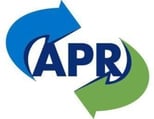
Would you rather save money on cheap packaging or choose a more sustainable option that was better for the environment and the long-term growth of your company? Wouldn’t you rather have an option that was both cost-effective and sustainable?
This idea of choosing between a quick cost-savings option and long-term sustainability is often a choice many businesses feel they need to make – but that doesn’t have to be the case. By choosing recyclable materials and packaging, you can both save money in the short-term and create a more sustainable solution for the long-term success of your company.
Here at MRP Solutions, that’s the future we’re working towards. That’s why we’re proud to have signed the New Plastics Economy Global Commitment from the Ellen MacArthur Foundation. This global initiative rallies businesses and governments around the shared vision of a circular economy for plastics, rethinking the way we design, use and reuse plastics.
 In addition to this support for the New Plastics Economy Global Commitment, we are also a member of the Association of Plastic Recyclers (APR). Working collaboratively with these organizations, our customers and suppliers, we are confident that we can play an instrumental role in helping to achieve a world without plastic pollution where all plastic we do need is 100% reusable, recyclable or compostable.
In addition to this support for the New Plastics Economy Global Commitment, we are also a member of the Association of Plastic Recyclers (APR). Working collaboratively with these organizations, our customers and suppliers, we are confident that we can play an instrumental role in helping to achieve a world without plastic pollution where all plastic we do need is 100% reusable, recyclable or compostable.
Here’s how our team at MRP and our collective partners are designing recyclable plastics packaging for the world of tomorrow:
Defining Recyclable
While we all know what it means for something to be recyclable on a basic level, there are several requirements for packaging to be fully compatible with the plastics recycling systems across the United States. According to the APR Design® Guide for Plastics Recyclability, for an item to be recyclable, it must meet the following conditions:
- 60% or more of consumers must have access to a reliable collection system that accepts the plastic packaging
- You can easily sort the packaging into market-ready bales of a particular plastic that meets industry standard specifications through common material recovery systems
- You can further process the packaging through a typical recycling process in a cost-efficient manner into a post consumer plastic feedstock so that it can be used for new products
Once met, these conditions help to ensure both the economic viability and sustainability of your packaging. APR Preferred package designs help you to achieve higher yields of marketable material while maximizing productivity and minimizing added costs.
Designing for Recyclability
Designing recyclable plastics packaging all starts with the resin that you’re using.
PET
PET, or polyethylene terephthalate, is one of the most widely used packaging resins due to its clarity and natural CO2 barrier properties. As such, many designs need to be built around the use of PET if you want to achieve a more sustainable solution.
Fortunately, PET is a highly recyclable plastic resin. Here’s how to achieve maximum recyclability with your PET packaging:
- Base Polymer: stick with a crystalline melting point between 225 and 255C
- Color: clear and unpigmented material has the highest recyclability, with transparent light blue or green colors great secondary choices
- Dimensions: packages should have a depth of two inches or more for proper sorting
- Closures and Dispensers: components that can float in water are best, and closures without liners are preferred
- Labels, Inks and Adhesives: labels with a specific gravity less than 1.0 are best, avoiding paper, PVC, and PLA labels
- Attachments: clear attachments are best, avoiding paper, PVC, PLA, and welded attachments
Note that PET often doesn’t have the right properties for closures, handles, labels or other attachments, forcing you to use other polymers to make these items and then attach them to your PET package. Any added polymers need to be addressed for how they could affect the recycling stream.
HDPE
If you need a tougher resin with higher chemical resistance and natural UV barrier properties, HDPE, or high-density polyethylene, is your go-to option. It naturally appears a milky white color, and is easily molded into bottles, tubs, or closures.
Here’s how you can achieve maximum recyclability with your HDPE packaging:
- Base Polymer: post consumer HDPE is encouraged as much as possible to enhance sustainability
- Color: natural, unpigmented material has the highest recyclability, with translucent or opaque colors the next best options
- Dimensions: packages should have a depth of two inches or more for proper sorting
- Closures and Dispensers: closures without liners are preferred
- Labels, Inks and Adhesives: in-mold labels of a compatible polymer and full bottle sleeve labels that are designed for sorting are best
- Attachments: stick with PETG tamper-evident safety sleeves and avoid PVC tamper-evident safety seals
PCR
As mentioned above, using PCR, or post consumer recycled resins, can have a significant impact on the sustainability of your packaging. Choosing PCR resins often leads to increased profits, improved cost savings, and a better brand image.
The more PCR resins you include in your packaging, the more sustainable and environmentally friendly your packaging will be. By creating your packaging out of recyclable material, and then recycling your packaging again once it’s served its purpose, you can close the loop on sustainable packaging.
We understand that PCR is a key component to ensure that we meet the sustainability goals set forth as a signatory of the New Plastics Economy Global Commitment. Sustainability is also a goal shared by many of our customers, and MRP Solutions is committed to helping achieve these goals. Our second episode of the Mold-Rite Pro Video Series is devoted to the topic of PCR.
Featuring MRP’s Senior Director of Sales, Wayne Johnson, this video provides additional insight into PCR & Sustainable Packaging. Additionally, we are excited to announce that we are trending successfully in protocol testing for up to 100% PCR CRC’s. As many customers and CPG’s strive to incorporate PCR, this major development will help brand owners meet their sustainability commitments. Click on the image on the left hand side to watch the episode.
More Sustainable Packaging at MRP Solutions
Here at MRP, we’re committed to working toward a circular economy for plastics. As an environmentally responsible manufacturer of packaging, we’re committed to greener processes, with many of our products are available in post consumer recycled resins. Our product design and production processes consider solutions that are not only business-friendly, but also environmentally-friendly.
Contact us today to learn more about how MRP can help you create better, more sustainable packaging.


